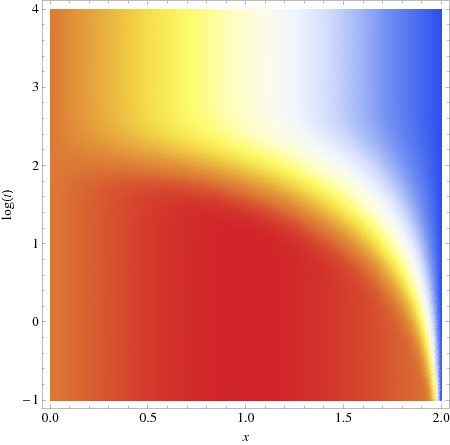5.6: Inhomogeneous Equations
( \newcommand{\kernel}{\mathrm{null}\,}\)
Consider a rod of length 2m, laterally insulated (heat only flows inside the rod). Initially the temperature u is
1ksin(πx2)+500 K.
The left and right ends are both attached to a thermostat, and the temperature at the left side is fixed at a temperature of 500 K and the right end at 100 K. There is also a heater attached to the rod that adds a constant heat of sin(πx2) to the rod. The differential equation describing this is inhomogeneous
∂∂tu=k∂2∂x2u+sin(πx2),u(0,t)=500,u(2,t)=100,u(x,0)=1ksin(πx2)+500.
ince the inhomogeneity is time-independent we write
u(x,t)=v(x,t)+h(x),
where h will be determined so as to make v satisfy a homogeneous equation. Substituting this form, we find
∂∂tv=k∂2∂x2v+kh″+sin(πx2).
To make the equation for v homogeneous we require h″(x)=−1ksin(πx2),
which has the solution
h(x)=C1x+C2+4kπ2sin(πx2).
At the same time we let h carry the boundary conditions, h(0)=500, h(2)=100, and thus h(x)=−200x+500+4kπ2sin(πx2). The function v satisfies
∂∂tv=k∂2∂x2v,v(0,t)=v(π,t)=0,v(x,0)=u(x,0)−h(x)=200x.
This is a problem of a type that we have seen before. By separation of variables we find
v(x,t)=∞∑n=1bnexp(−n2π24kt)sinnπ2x.
The initial condition gives
∞∑n=1bnsinnx=200x.
from which we find
bn=(−1)n+1800nπ.
And thus
u(x,t)=−200x+500+4π2ksin(πx2)+800π∞∑n=1(−1)nn+1sin(πnx2)e−k(nπ/2)2t.
Note: as t→∞, u(x,t)→−400πx+500+sinπ2xk. As can be seen in Fig. 5.6.1 this approach is quite rapid – we have chosen k=1/500 in that figure, and summed over the first 60 solutions.

Figure 5.6.1: Time dependence of the solution to the inhomogeneous Equation ???.


